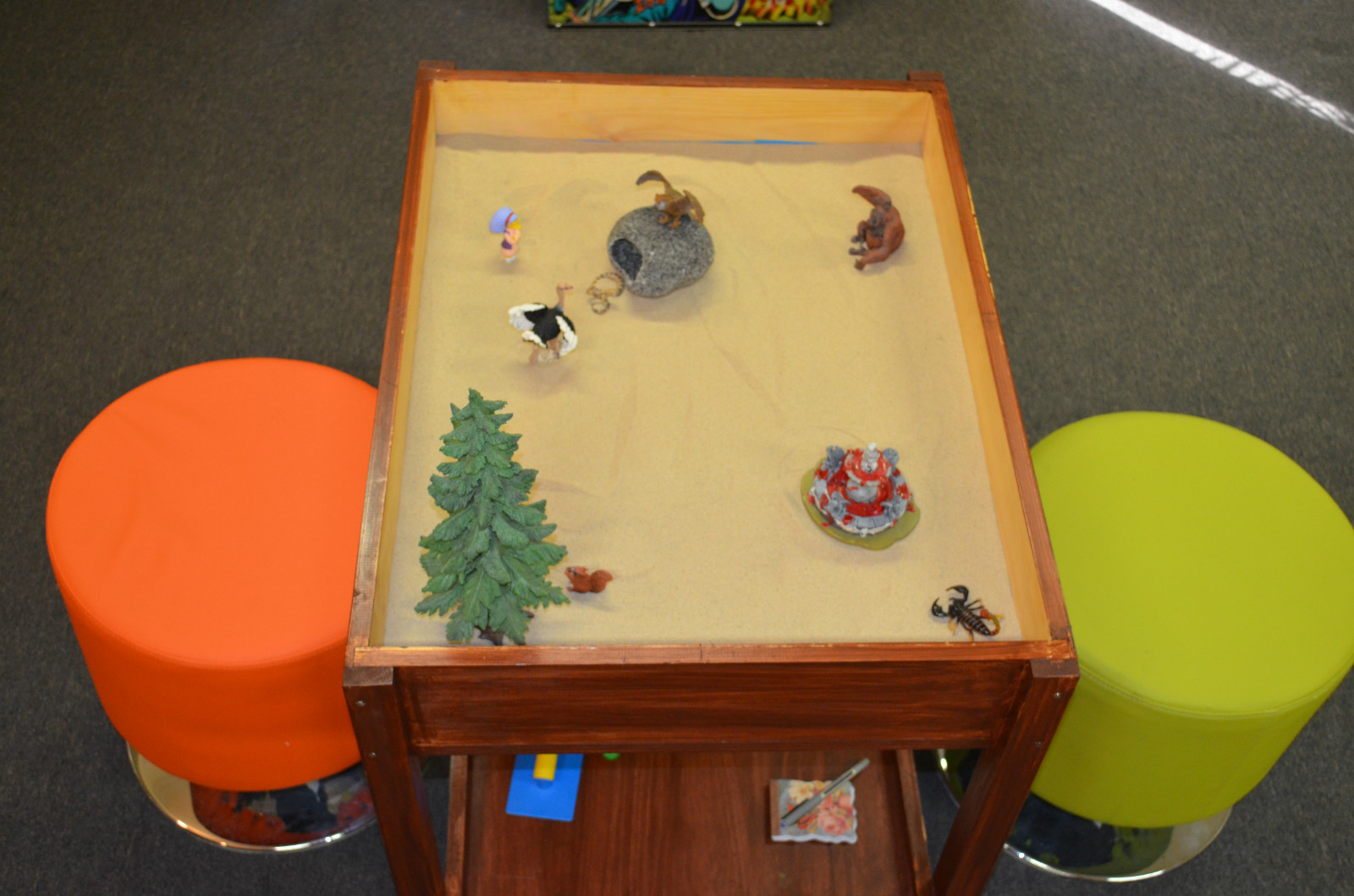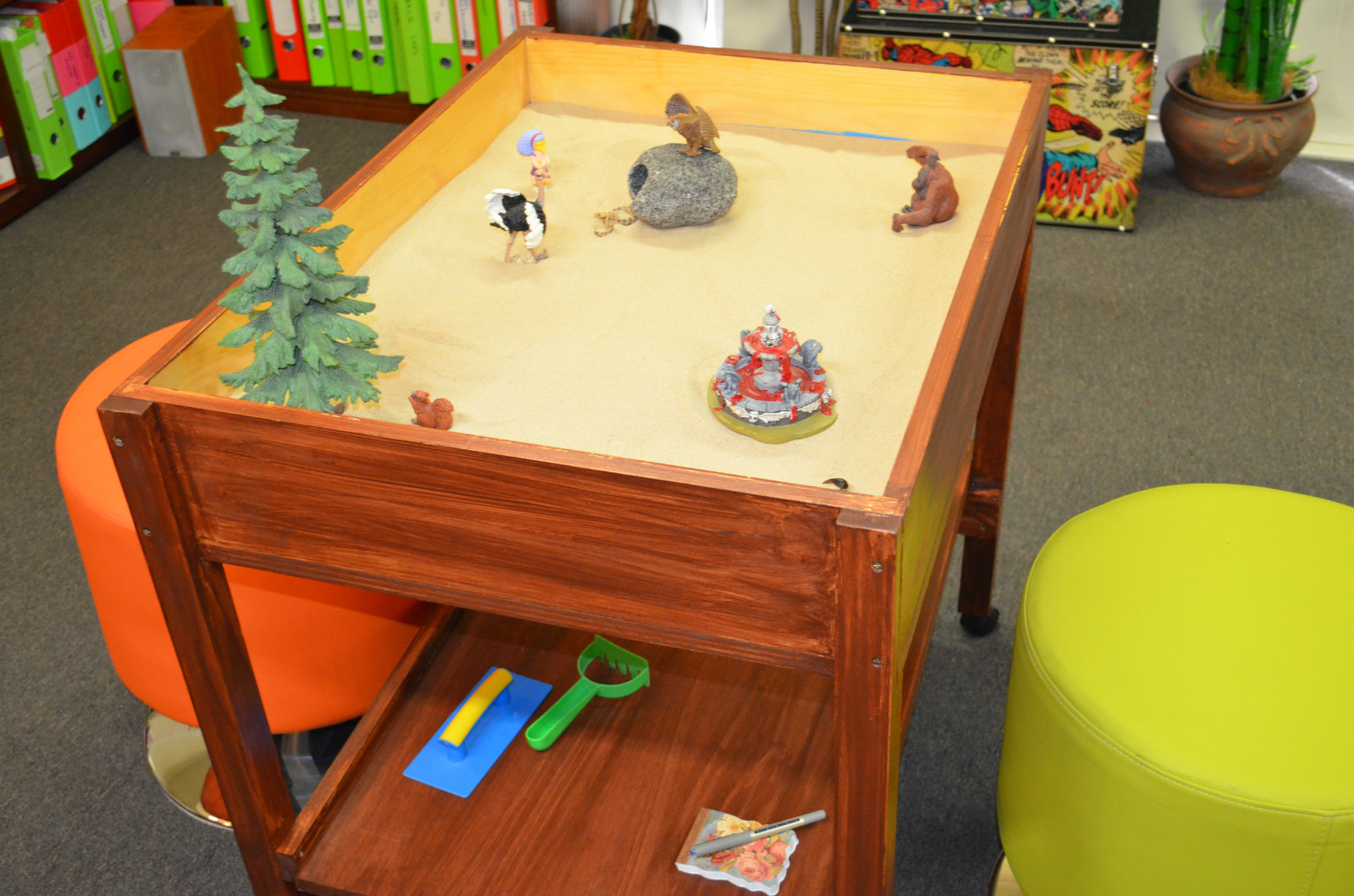Sandplay therapy is a recognised therapeutic modality for both children and adults, based on the psychology of C.G. Jung and developed by the Swiss psychotherapist and teacher Dora Kalff. It is particularly useful for identifying and reconciling internal conflicts that manifest as anxiety and depression, as well as penetrating the depths of personality to experience the Self directly. Sandplay therapy establishes a safe and protected space, where the complexities of the inner world are explored and integrated into the psyche for emotional healing.
Sandplay is hands on psychological work. It is a powerful therapeutic technique that facilitates the mind’s natural capacity for healing. In a “free and protected” space provided by a trained Sandplay therapist, the client creates a concrete manifestation of his or her imagination using sand, water, and small objects. In this way Sandplay helps honour and illuminate the individual’s inner symbolic world, providing a place for its expression within a safe container.
Sandplay provides a way for material from the unconscious to become visible, healed, and integrated into the consciousness, thus allowing life to be lived in a more conscious and authentic way. Related neurobiological research supports the fact that emotional memories and traumatic sensory experiences are stored in the limbic system and right hemisphere of the brain, along with non-verbal, sensory experiences such as images, body sensations, and emotions.
Non-verbal therapies like Sandplay are the most effective ways to access and release these “unconscious” feelings and experiences and bring them into consciousness, where they can be healed. Sandplay also provides a visual and non-verbal avenue for the psyche to develop and become whole. It is a direct method to establish an inner connection with the greater Self, which Carl Jung encouraged as an essential step for healthy psychological development.
What a Sandplay Therapy Session Looks Like
People in therapy are encouraged to use miniature toys, figurines, and objects in the sand in ways they choose, while the therapist observes and later analyses the person’s interaction. The person in therapy can add water to the sand and place the miniatures in the sand tray in any order. The design of the sand tray is guided by their imagination and their subconscious. The result is a microcosm of their inner world.
The world within the sand tray is expressed through symbolism and metaphor, and may not even make immediate sense to the person creating it. But aided by the therapist, a person in therapy—even a child—can begin to recognise the relationship between the creation in the sand and their inner world.
Clients place miniature figurines in a small Sandtray to express complicated feelings and emotional experiences. Creating a visual representation of the psyche’s contents and reveals unconscious concerns that are inaccessible any other way. As materials contained in the unconscious emerges visually and symbolically, it is integrated into a person’s sense of self and can be activated to elicit behavioural change.
With sufficient time and understanding, a Sandplay experience can lead the client into layers of experience that are pre-verbal and long forgotten to the conscious mind. Through the tangible emergence of personal and archetypal symbols in the tray in a safe environment, the client moves toward a sense of balance and wholeness.
The effectiveness of Sandplay therapy comes with an understanding of Jungian psychology, as well as the archetypal and personal symbolism that appears in the sand. Knowledge of symbolic language creates a foundation not only for Sandplay therapy but also for dream analysis and all non-verbal therapies involving art and play.
Sandplay or Sandtray?
Sandplay Therapy is often confused with sandtray, which is a generic term describing how boxes of sand are used with small toys as part of a child’s play therapy program. The underlying principles and therapeutic use of Sandplay and sandtray are quite distinct, although symbolic images and sandtrays are utilised in both modalities. Sandplays are created in a free and protected space, where the therapist does not interpret, interfere with, or direct the client’s symbolic expression. The Sandplay Therapist maintains an attitude of receptivity and acceptance so that the client can bring unconscious material into consciousness without censure. It follows the principles of Carl Rogers’ client-centred therapy and allows the psyche to develop into a natural and fundamental state of wholeness.
Sandplay Therapy for Trauma, Neglect, or Abuse
Many children are unable to verbalise emotional states, particularly in the face of trauma, neglect, or abuse. The non-verbal nature of Sandplay Therapy and the familiar medium of sand can help children achieve feelings of comfort and security. With little instruction from the therapist, the child is free to play and develop his or her own expression of situations. The children will often experience a sense of independent play and will begin making assumptions and behaviour changes without cues from the therapist. This method of therapy serves as a valuable and powerful outlet for children and an incredibly insightful method of gaining access to traumatic experiences.
Sandplay Therapy is also very useful in the treatment of children who have been sexually abused. Such children will often remain silent for fear of harm or even death. They are often threatened and are in highly anxious states when they come to therapy. The relaxed and interactive setting of Sandplay Therapy provides them with the first arena of safety that they need to move toward healing.
Sandplay Therapy for Adults
Although Sandplay Therapy may look like child’s play, it is a highly therapeutic and multidimensional form of therapy that can provide emotional release and realisation for a person in therapy. Adults who have been traumatised and show limited response to other types of therapy may respond well to Sandplay Therapy. The environment presents an atmosphere free from threats, and the therapist works with the person in treatment to alter the positions of the miniature objects as representations of the individuals and events. By beginning to facilitate change on a fictitious level, a person can gain the courage and ability to recognise that these same changes can be made in his or her life. While the Sandplay process involves creating a series of trays and might last for months or years, significant change may be experienced in just one sand tray session.
What is the History of Sandplay Therapy?
Sandplay was developed by Swiss Jungian Analyst Dora Kalff. Sandplay is a form of therapy that gives both child and adult clients the opportunity to portray, rather than verbalise, feelings and experiences often inaccessible or difficult to express in words. Sandplay also provides a balance to the extroverted, verbal, and outer-focused everyday world. It can lead to a more open and integrated way of life. A basic premise of Sandplay Therapy is that the psyche possesses a natural tendency to heal itself, given the proper conditions. Similar to how our physical wounds heal under beneficial conditions, the psyche also has an instinctual wisdom that emerges when left free to operate naturally in a protected environment. The aim of Sandplay is to activate healing energies at the deepest level of the psyche through the use of miniatures and the sand tray to reflect the client’s inner world. By this symbolic activity and through the experience of free and creative play, unconscious processes are made visible in this three-dimensional form, much like the dream experience. Since Sandplay is one of the few therapeutic techniques in which language skills are unnecessary for understanding the expressions of the psyche, it has become a cross-cultural method that is now practised therapeutically worldwide. Within this ever-shrinking world, Sandplay now offers us a unique opportunity to view universal, archetypal patterns as well as observe the unfolding development of the individual psyche.













